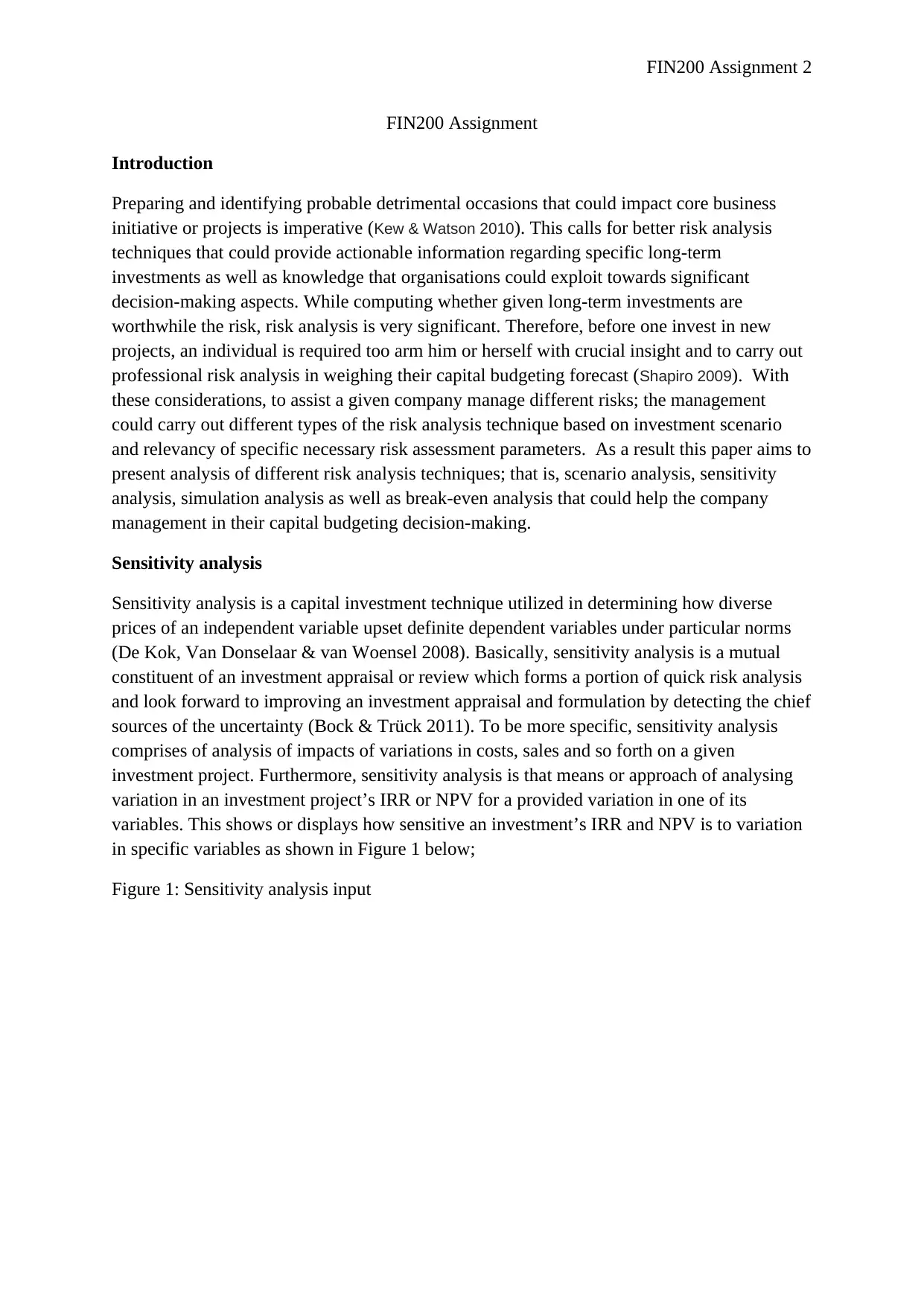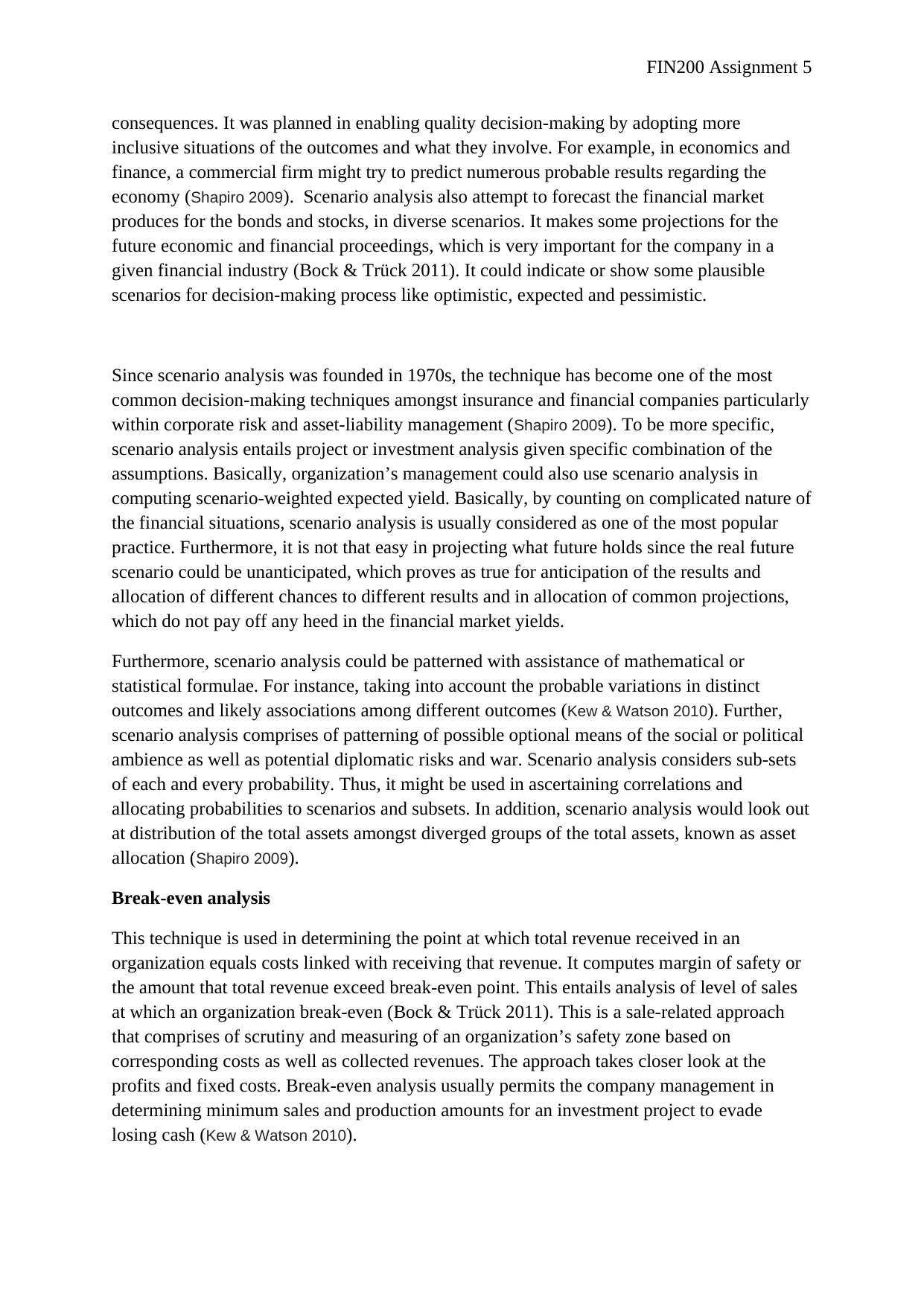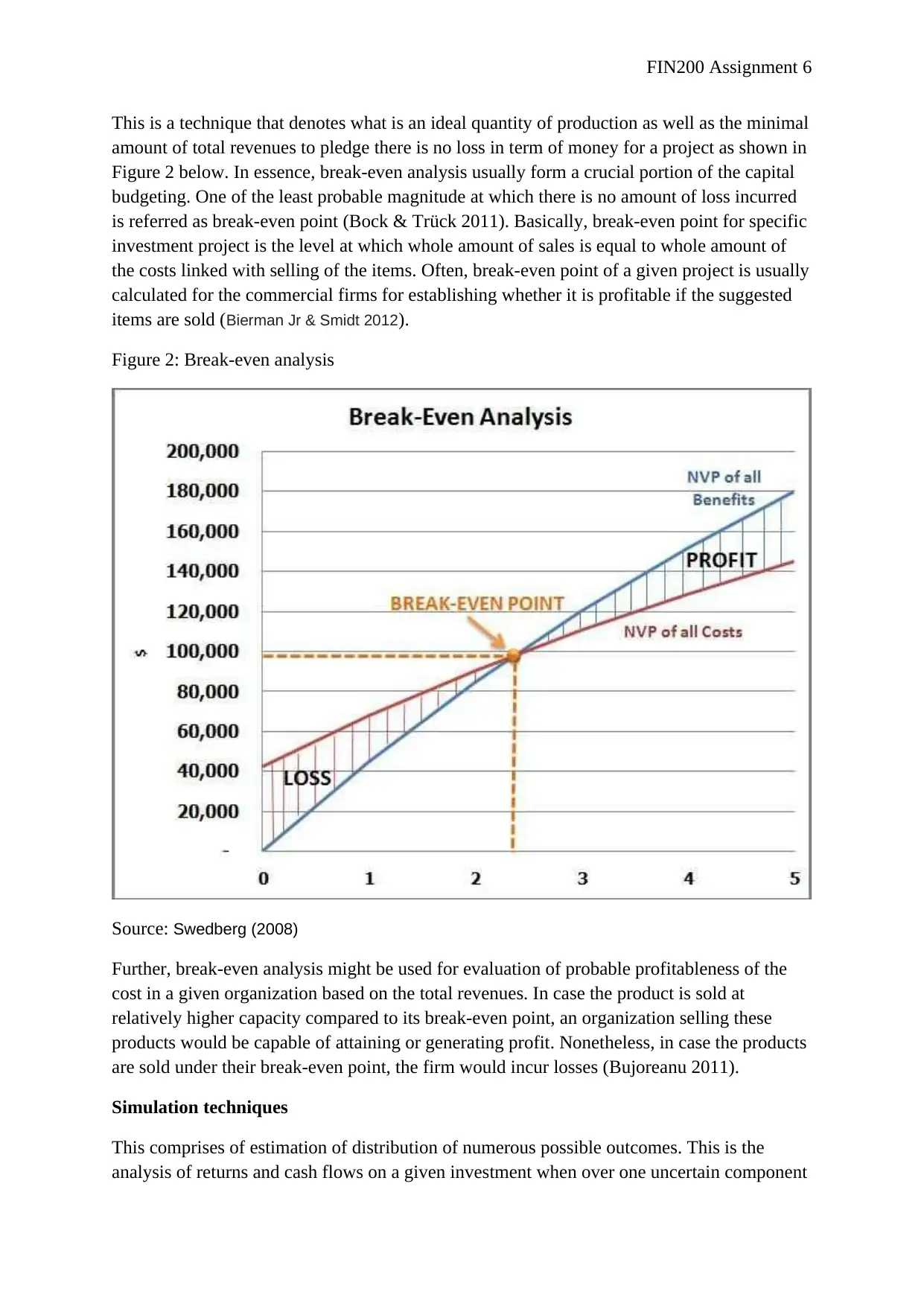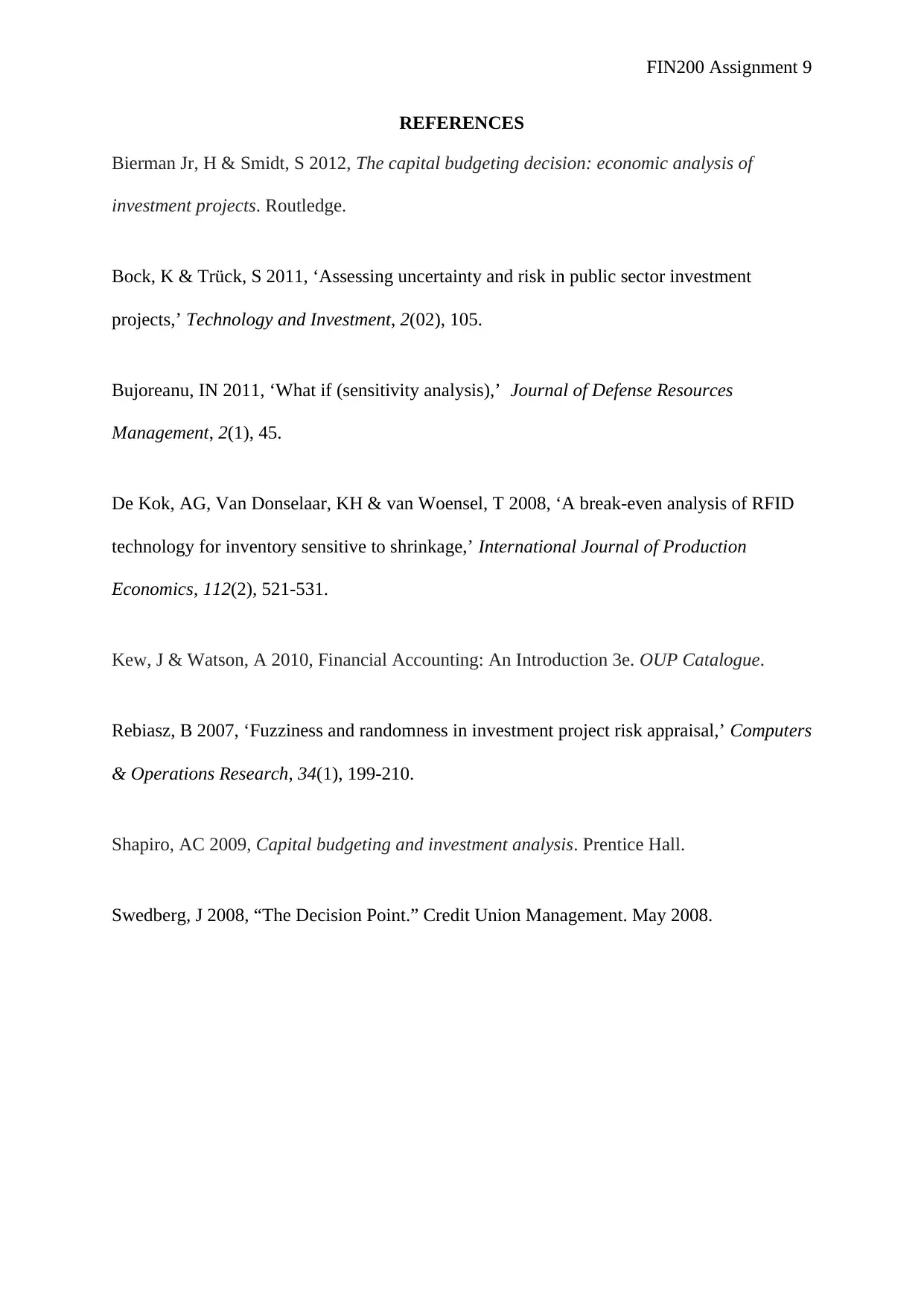FIN200 Assignment 9: Analysis of Risk Analysis Techniques
VerifiedAdded on 2020/02/24
|9
|2574
|29
Report
AI Summary
This report analyzes several risk analysis techniques crucial for capital budgeting and investment decision-making. It begins by emphasizing the importance of identifying and mitigating potential risks in business initiatives. The report then delves into specific techniques, starting with sensitivity analysis...

FIN200 Assignment 1
FIN200 ASSIGNMENT
Student’s Name
Course
Lecturer
Institution
Date
FIN200 ASSIGNMENT
Student’s Name
Course
Lecturer
Institution
Date
Paraphrase This Document
Need a fresh take? Get an instant paraphrase of this document with our AI Paraphraser

FIN200 Assignment 2
FIN200 Assignment
Introduction
Preparing and identifying probable detrimental occasions that could impact core business
initiative or projects is imperative (Kew & Watson 2010). This calls for better risk analysis
techniques that could provide actionable information regarding specific long-term
investments as well as knowledge that organisations could exploit towards significant
decision-making aspects. While computing whether given long-term investments are
worthwhile the risk, risk analysis is very significant. Therefore, before one invest in new
projects, an individual is required too arm him or herself with crucial insight and to carry out
professional risk analysis in weighing their capital budgeting forecast (Shapiro 2009). With
these considerations, to assist a given company manage different risks; the management
could carry out different types of the risk analysis technique based on investment scenario
and relevancy of specific necessary risk assessment parameters. As a result this paper aims to
present analysis of different risk analysis techniques; that is, scenario analysis, sensitivity
analysis, simulation analysis as well as break-even analysis that could help the company
management in their capital budgeting decision-making.
Sensitivity analysis
Sensitivity analysis is a capital investment technique utilized in determining how diverse
prices of an independent variable upset definite dependent variables under particular norms
(De Kok, Van Donselaar & van Woensel 2008). Basically, sensitivity analysis is a mutual
constituent of an investment appraisal or review which forms a portion of quick risk analysis
and look forward to improving an investment appraisal and formulation by detecting the chief
sources of the uncertainty (Bock & Trück 2011). To be more specific, sensitivity analysis
comprises of analysis of impacts of variations in costs, sales and so forth on a given
investment project. Furthermore, sensitivity analysis is that means or approach of analysing
variation in an investment project’s IRR or NPV for a provided variation in one of its
variables. This shows or displays how sensitive an investment’s IRR and NPV is to variation
in specific variables as shown in Figure 1 below;
Figure 1: Sensitivity analysis input
FIN200 Assignment
Introduction
Preparing and identifying probable detrimental occasions that could impact core business
initiative or projects is imperative (Kew & Watson 2010). This calls for better risk analysis
techniques that could provide actionable information regarding specific long-term
investments as well as knowledge that organisations could exploit towards significant
decision-making aspects. While computing whether given long-term investments are
worthwhile the risk, risk analysis is very significant. Therefore, before one invest in new
projects, an individual is required too arm him or herself with crucial insight and to carry out
professional risk analysis in weighing their capital budgeting forecast (Shapiro 2009). With
these considerations, to assist a given company manage different risks; the management
could carry out different types of the risk analysis technique based on investment scenario
and relevancy of specific necessary risk assessment parameters. As a result this paper aims to
present analysis of different risk analysis techniques; that is, scenario analysis, sensitivity
analysis, simulation analysis as well as break-even analysis that could help the company
management in their capital budgeting decision-making.
Sensitivity analysis
Sensitivity analysis is a capital investment technique utilized in determining how diverse
prices of an independent variable upset definite dependent variables under particular norms
(De Kok, Van Donselaar & van Woensel 2008). Basically, sensitivity analysis is a mutual
constituent of an investment appraisal or review which forms a portion of quick risk analysis
and look forward to improving an investment appraisal and formulation by detecting the chief
sources of the uncertainty (Bock & Trück 2011). To be more specific, sensitivity analysis
comprises of analysis of impacts of variations in costs, sales and so forth on a given
investment project. Furthermore, sensitivity analysis is that means or approach of analysing
variation in an investment project’s IRR or NPV for a provided variation in one of its
variables. This shows or displays how sensitive an investment’s IRR and NPV is to variation
in specific variables as shown in Figure 1 below;
Figure 1: Sensitivity analysis input

FIN200 Assignment 3
Source: De Kok, Van Donselaar & van Woensel (2008)
Sensitivity analysis is that explanation of probable cash returns as well as return on a given
investment when one indeterminate component is altered (De Kok, Van Donselaar & van
Woensel 2008). It illustrates the impacts of variations in the assumptions. This technique
utilizes numerous scenario probabilities in modelling a wide range of the probable results in
assessing alternative business decisions. It also permits organizations in determining the
effect of the risks and outcomes in a given investment project. Sensitivity analysis is said to
demonstrate model output variations in accordance with the model input changes as shown in
Figure 2 below. Here, a model regarded as the sensitive model with respect to the input if
adjusting variable input modifies model output (Bujoreanu 2011). Furthermore, in sensitivity
analysis, mathematical model could outlined with assistance of several input components,
variable quantities, set of equations as well as other parameters, which are targeted in
describing procedures being utilized.
Figure 2: sensitivity analysis model output
Source: De Kok, Van Donselaar & van Woensel (2008)
Sensitivity analysis is that explanation of probable cash returns as well as return on a given
investment when one indeterminate component is altered (De Kok, Van Donselaar & van
Woensel 2008). It illustrates the impacts of variations in the assumptions. This technique
utilizes numerous scenario probabilities in modelling a wide range of the probable results in
assessing alternative business decisions. It also permits organizations in determining the
effect of the risks and outcomes in a given investment project. Sensitivity analysis is said to
demonstrate model output variations in accordance with the model input changes as shown in
Figure 2 below. Here, a model regarded as the sensitive model with respect to the input if
adjusting variable input modifies model output (Bujoreanu 2011). Furthermore, in sensitivity
analysis, mathematical model could outlined with assistance of several input components,
variable quantities, set of equations as well as other parameters, which are targeted in
describing procedures being utilized.
Figure 2: sensitivity analysis model output
⊘ This is a preview!⊘
Do you want full access?
Subscribe today to unlock all pages.

Trusted by 1+ million students worldwide

FIN200 Assignment 4
Source: Bock & Trück (2011)
Furthermore, sensitivity analysis is used in ascertaining similarity of model with procedure in
the consideration. It is also used in ascertaining elements that greatly contribute to change in
given output as well as in ascertaining the realm in the input components for which
inconsistency of ideal is at the uppermost (Shapiro 2009). Further, sensitivity analysis is also
used in ascertaining mutual or the reciprocal happening between different components or in
ascertaining optimal and unstable domains in areas of the components for applications in the
ensuant calibration research.
In sensitivity analysis, following steps are followed; first, the financial manager identifies all
those variables that have some influence on an investment’s IRR or NPV (Bujoreanu 2011).
Secondly, the financial manager conducts an assessment or evaluation of effect of the
variation in all variables on an investment’s NPV. Finally, the manager defines underlying
quantitative relationship in between the variables. Therefore, sensitivity analysis technique is
very useful for the company management in comprehending the totality of the investment
projects.
Scenario analysis
This is a basic tool that is implemented in evaluating uncertainty and risk about future
forecasts of a given investment opportunity. Basically, scenario analysis helps in assessing
upshot of numerous substitutes on the investment’s expansion. Here, joint deliberation of
specific pessimistic and optimistic values of the project variables facilitates in demonstrating
numerous scenarios within a given hypotheses. Further, it is a technique of evaluating
possible future events by taking in consideration of alternative probable scenarios or
Source: Bock & Trück (2011)
Furthermore, sensitivity analysis is used in ascertaining similarity of model with procedure in
the consideration. It is also used in ascertaining elements that greatly contribute to change in
given output as well as in ascertaining the realm in the input components for which
inconsistency of ideal is at the uppermost (Shapiro 2009). Further, sensitivity analysis is also
used in ascertaining mutual or the reciprocal happening between different components or in
ascertaining optimal and unstable domains in areas of the components for applications in the
ensuant calibration research.
In sensitivity analysis, following steps are followed; first, the financial manager identifies all
those variables that have some influence on an investment’s IRR or NPV (Bujoreanu 2011).
Secondly, the financial manager conducts an assessment or evaluation of effect of the
variation in all variables on an investment’s NPV. Finally, the manager defines underlying
quantitative relationship in between the variables. Therefore, sensitivity analysis technique is
very useful for the company management in comprehending the totality of the investment
projects.
Scenario analysis
This is a basic tool that is implemented in evaluating uncertainty and risk about future
forecasts of a given investment opportunity. Basically, scenario analysis helps in assessing
upshot of numerous substitutes on the investment’s expansion. Here, joint deliberation of
specific pessimistic and optimistic values of the project variables facilitates in demonstrating
numerous scenarios within a given hypotheses. Further, it is a technique of evaluating
possible future events by taking in consideration of alternative probable scenarios or
Paraphrase This Document
Need a fresh take? Get an instant paraphrase of this document with our AI Paraphraser

FIN200 Assignment 5
consequences. It was planned in enabling quality decision-making by adopting more
inclusive situations of the outcomes and what they involve. For example, in economics and
finance, a commercial firm might try to predict numerous probable results regarding the
economy (Shapiro 2009). Scenario analysis also attempt to forecast the financial market
produces for the bonds and stocks, in diverse scenarios. It makes some projections for the
future economic and financial proceedings, which is very important for the company in a
given financial industry (Bock & Trück 2011). It could indicate or show some plausible
scenarios for decision-making process like optimistic, expected and pessimistic.
Since scenario analysis was founded in 1970s, the technique has become one of the most
common decision-making techniques amongst insurance and financial companies particularly
within corporate risk and asset-liability management (Shapiro 2009). To be more specific,
scenario analysis entails project or investment analysis given specific combination of the
assumptions. Basically, organization’s management could also use scenario analysis in
computing scenario-weighted expected yield. Basically, by counting on complicated nature of
the financial situations, scenario analysis is usually considered as one of the most popular
practice. Furthermore, it is not that easy in projecting what future holds since the real future
scenario could be unanticipated, which proves as true for anticipation of the results and
allocation of different chances to different results and in allocation of common projections,
which do not pay off any heed in the financial market yields.
Furthermore, scenario analysis could be patterned with assistance of mathematical or
statistical formulae. For instance, taking into account the probable variations in distinct
outcomes and likely associations among different outcomes (Kew & Watson 2010). Further,
scenario analysis comprises of patterning of possible optional means of the social or political
ambience as well as potential diplomatic risks and war. Scenario analysis considers sub-sets
of each and every probability. Thus, it might be used in ascertaining correlations and
allocating probabilities to scenarios and subsets. In addition, scenario analysis would look out
at distribution of the total assets amongst diverged groups of the total assets, known as asset
allocation (Shapiro 2009).
Break-even analysis
This technique is used in determining the point at which total revenue received in an
organization equals costs linked with receiving that revenue. It computes margin of safety or
the amount that total revenue exceed break-even point. This entails analysis of level of sales
at which an organization break-even (Bock & Trück 2011). This is a sale-related approach
that comprises of scrutiny and measuring of an organization’s safety zone based on
corresponding costs as well as collected revenues. The approach takes closer look at the
profits and fixed costs. Break-even analysis usually permits the company management in
determining minimum sales and production amounts for an investment project to evade
losing cash (Kew & Watson 2010).
consequences. It was planned in enabling quality decision-making by adopting more
inclusive situations of the outcomes and what they involve. For example, in economics and
finance, a commercial firm might try to predict numerous probable results regarding the
economy (Shapiro 2009). Scenario analysis also attempt to forecast the financial market
produces for the bonds and stocks, in diverse scenarios. It makes some projections for the
future economic and financial proceedings, which is very important for the company in a
given financial industry (Bock & Trück 2011). It could indicate or show some plausible
scenarios for decision-making process like optimistic, expected and pessimistic.
Since scenario analysis was founded in 1970s, the technique has become one of the most
common decision-making techniques amongst insurance and financial companies particularly
within corporate risk and asset-liability management (Shapiro 2009). To be more specific,
scenario analysis entails project or investment analysis given specific combination of the
assumptions. Basically, organization’s management could also use scenario analysis in
computing scenario-weighted expected yield. Basically, by counting on complicated nature of
the financial situations, scenario analysis is usually considered as one of the most popular
practice. Furthermore, it is not that easy in projecting what future holds since the real future
scenario could be unanticipated, which proves as true for anticipation of the results and
allocation of different chances to different results and in allocation of common projections,
which do not pay off any heed in the financial market yields.
Furthermore, scenario analysis could be patterned with assistance of mathematical or
statistical formulae. For instance, taking into account the probable variations in distinct
outcomes and likely associations among different outcomes (Kew & Watson 2010). Further,
scenario analysis comprises of patterning of possible optional means of the social or political
ambience as well as potential diplomatic risks and war. Scenario analysis considers sub-sets
of each and every probability. Thus, it might be used in ascertaining correlations and
allocating probabilities to scenarios and subsets. In addition, scenario analysis would look out
at distribution of the total assets amongst diverged groups of the total assets, known as asset
allocation (Shapiro 2009).
Break-even analysis
This technique is used in determining the point at which total revenue received in an
organization equals costs linked with receiving that revenue. It computes margin of safety or
the amount that total revenue exceed break-even point. This entails analysis of level of sales
at which an organization break-even (Bock & Trück 2011). This is a sale-related approach
that comprises of scrutiny and measuring of an organization’s safety zone based on
corresponding costs as well as collected revenues. The approach takes closer look at the
profits and fixed costs. Break-even analysis usually permits the company management in
determining minimum sales and production amounts for an investment project to evade
losing cash (Kew & Watson 2010).

FIN200 Assignment 6
This is a technique that denotes what is an ideal quantity of production as well as the minimal
amount of total revenues to pledge there is no loss in term of money for a project as shown in
Figure 2 below. In essence, break-even analysis usually form a crucial portion of the capital
budgeting. One of the least probable magnitude at which there is no amount of loss incurred
is referred as break-even point (Bock & Trück 2011). Basically, break-even point for specific
investment project is the level at which whole amount of sales is equal to whole amount of
the costs linked with selling of the items. Often, break-even point of a given project is usually
calculated for the commercial firms for establishing whether it is profitable if the suggested
items are sold (Bierman Jr & Smidt 2012).
Figure 2: Break-even analysis
Source: Swedberg (2008)
Further, break-even analysis might be used for evaluation of probable profitableness of the
cost in a given organization based on the total revenues. In case the product is sold at
relatively higher capacity compared to its break-even point, an organization selling these
products would be capable of attaining or generating profit. Nonetheless, in case the products
are sold under their break-even point, the firm would incur losses (Bujoreanu 2011).
Simulation techniques
This comprises of estimation of distribution of numerous possible outcomes. This is the
analysis of returns and cash flows on a given investment when over one uncertain component
This is a technique that denotes what is an ideal quantity of production as well as the minimal
amount of total revenues to pledge there is no loss in term of money for a project as shown in
Figure 2 below. In essence, break-even analysis usually form a crucial portion of the capital
budgeting. One of the least probable magnitude at which there is no amount of loss incurred
is referred as break-even point (Bock & Trück 2011). Basically, break-even point for specific
investment project is the level at which whole amount of sales is equal to whole amount of
the costs linked with selling of the items. Often, break-even point of a given project is usually
calculated for the commercial firms for establishing whether it is profitable if the suggested
items are sold (Bierman Jr & Smidt 2012).
Figure 2: Break-even analysis
Source: Swedberg (2008)
Further, break-even analysis might be used for evaluation of probable profitableness of the
cost in a given organization based on the total revenues. In case the product is sold at
relatively higher capacity compared to its break-even point, an organization selling these
products would be capable of attaining or generating profit. Nonetheless, in case the products
are sold under their break-even point, the firm would incur losses (Bujoreanu 2011).
Simulation techniques
This comprises of estimation of distribution of numerous possible outcomes. This is the
analysis of returns and cash flows on a given investment when over one uncertain component
⊘ This is a preview!⊘
Do you want full access?
Subscribe today to unlock all pages.

Trusted by 1+ million students worldwide

FIN200 Assignment 7
is considered. To be more specific, simulation analysis is the statistically based behavioural
technique that applies the prearranged or scheduled probability distributions as well as
arbitrary numbers in estimating risky results or outcomes (De Kok, Van Donselaar & van
Woensel 2008). By use of simulation analysis, through trying or analysing numerous cash
flow constituents in scientific ideal and restating that procedure, the management could
cultivate the probability distribution of the appraised or assessed earnings (Bierman Jr & Smidt
2012).
Simulation analysis is mostly used in formulating probability analysis for the standard of the
merit with assistance of random combination of the values which carry the relations with
designated standard. With assistance of sensitivity analysis, sensitivity of IRR, NPV as well
as other criterion of merit like payback period could be ascertained (Bock & Trück 2011).
Basically, simulation analysis usually gives data such as in instances where quantity sold and
produced is decreased by 1%, other aspects remaining constant, NPV also deceased by
around 6%. This info, though it could be of great assistance cannot be adequate enough with
in making investment decision. Financial managers or the company management also needs
to have some rough idea in regard to probability of such happening which could be rendered
by the simulation analysis (Shapiro 2009).
The approach permits financial managers in developing the probability distribution of the
probable outcomes or results, given the probability distribution for every variable that might
change. This technique of analysis is a bit realistic as compared to sensitivity analysis since it
introduces uncertainty for numerous variables in an analysis (Bock & Trück 2011).
Nonetheless, it might become complex since there are some interdependencies amongst
numerous variables within a given period and interdependencies amongst variables within
different times.
In conducting simulation analysis, following steps are followed. First, the manager defines
the project precisely. The defining the project demonstrates relationship that exist between
NPV with numerous aspects and external variable quantities (Swedberg 2008). These aspects
are viewed as variable inputs outlined or defined by decision-making authority and remain
unaltered in each simulation run. External variables are those variable inputs which tend to
have random features and are far much beyond the effect of decision-making authority.
Secondly, the manager constructs the numerical model by assigning probability distribution
of the external variables and parameter values. This also comprises of selecting rate in
stochastic way by gathering the charge from probability section external variable. Third, the
financial manager set up the probable course of action in testing the project (Bock & Trück
2011). Fourth, the financial manager should introduce all the variables linked with the project
as well as run the experiment. This entails ascertaining whether the NPV matches with
stochastically produced variables. The financial manager should consider results and
possibilities in adjusting the model or alter the data inputs.
Conclusion
Based on the above analysis of the numerous techniques employed during investment
decision, it could be concluded that organization’s management could be linked with NPV,
is considered. To be more specific, simulation analysis is the statistically based behavioural
technique that applies the prearranged or scheduled probability distributions as well as
arbitrary numbers in estimating risky results or outcomes (De Kok, Van Donselaar & van
Woensel 2008). By use of simulation analysis, through trying or analysing numerous cash
flow constituents in scientific ideal and restating that procedure, the management could
cultivate the probability distribution of the appraised or assessed earnings (Bierman Jr & Smidt
2012).
Simulation analysis is mostly used in formulating probability analysis for the standard of the
merit with assistance of random combination of the values which carry the relations with
designated standard. With assistance of sensitivity analysis, sensitivity of IRR, NPV as well
as other criterion of merit like payback period could be ascertained (Bock & Trück 2011).
Basically, simulation analysis usually gives data such as in instances where quantity sold and
produced is decreased by 1%, other aspects remaining constant, NPV also deceased by
around 6%. This info, though it could be of great assistance cannot be adequate enough with
in making investment decision. Financial managers or the company management also needs
to have some rough idea in regard to probability of such happening which could be rendered
by the simulation analysis (Shapiro 2009).
The approach permits financial managers in developing the probability distribution of the
probable outcomes or results, given the probability distribution for every variable that might
change. This technique of analysis is a bit realistic as compared to sensitivity analysis since it
introduces uncertainty for numerous variables in an analysis (Bock & Trück 2011).
Nonetheless, it might become complex since there are some interdependencies amongst
numerous variables within a given period and interdependencies amongst variables within
different times.
In conducting simulation analysis, following steps are followed. First, the manager defines
the project precisely. The defining the project demonstrates relationship that exist between
NPV with numerous aspects and external variable quantities (Swedberg 2008). These aspects
are viewed as variable inputs outlined or defined by decision-making authority and remain
unaltered in each simulation run. External variables are those variable inputs which tend to
have random features and are far much beyond the effect of decision-making authority.
Secondly, the manager constructs the numerical model by assigning probability distribution
of the external variables and parameter values. This also comprises of selecting rate in
stochastic way by gathering the charge from probability section external variable. Third, the
financial manager set up the probable course of action in testing the project (Bock & Trück
2011). Fourth, the financial manager should introduce all the variables linked with the project
as well as run the experiment. This entails ascertaining whether the NPV matches with
stochastically produced variables. The financial manager should consider results and
possibilities in adjusting the model or alter the data inputs.
Conclusion
Based on the above analysis of the numerous techniques employed during investment
decision, it could be concluded that organization’s management could be linked with NPV,
Paraphrase This Document
Need a fresh take? Get an instant paraphrase of this document with our AI Paraphraser

FIN200 Assignment 8
IRR and other capital budgeting techniques. This is based on the notion that while conducting
the analysis using the above techniques, NPV and IRR stands as crucial measures of merit in
decision-making since they help in measuring how sensitive an investment’s IRR and NPV is
to variation in specific variables. Furthermore, the management decisions could be linked
with capital budgeting techniques such as NPV and IRR since their decisions focuses on
variation at a time which is same case as the capital budgeting techniques. In addition,
management decisions could be related with the capital budgeting techniques since in making
decision, using various risk analysis techniques, utilizes probabilities in modelling a wide
range of the probable results in assessing alternative business decisions. This permits
organization’s management in determining the effect of the risks and outcomes in a given
investment project. This is same case as in capital budgeting techniques like NPV and IRR.
IRR and other capital budgeting techniques. This is based on the notion that while conducting
the analysis using the above techniques, NPV and IRR stands as crucial measures of merit in
decision-making since they help in measuring how sensitive an investment’s IRR and NPV is
to variation in specific variables. Furthermore, the management decisions could be linked
with capital budgeting techniques such as NPV and IRR since their decisions focuses on
variation at a time which is same case as the capital budgeting techniques. In addition,
management decisions could be related with the capital budgeting techniques since in making
decision, using various risk analysis techniques, utilizes probabilities in modelling a wide
range of the probable results in assessing alternative business decisions. This permits
organization’s management in determining the effect of the risks and outcomes in a given
investment project. This is same case as in capital budgeting techniques like NPV and IRR.

FIN200 Assignment 9
REFERENCES
Bierman Jr, H & Smidt, S 2012, The capital budgeting decision: economic analysis of
investment projects. Routledge.
Bock, K & Trück, S 2011, ‘Assessing uncertainty and risk in public sector investment
projects,’ Technology and Investment, 2(02), 105.
Bujoreanu, IN 2011, ‘What if (sensitivity analysis),’ Journal of Defense Resources
Management, 2(1), 45.
De Kok, AG, Van Donselaar, KH & van Woensel, T 2008, ‘A break-even analysis of RFID
technology for inventory sensitive to shrinkage,’ International Journal of Production
Economics, 112(2), 521-531.
Kew, J & Watson, A 2010, Financial Accounting: An Introduction 3e. OUP Catalogue.
Rebiasz, B 2007, ‘Fuzziness and randomness in investment project risk appraisal,’ Computers
& Operations Research, 34(1), 199-210.
Shapiro, AC 2009, Capital budgeting and investment analysis. Prentice Hall.
Swedberg, J 2008, “The Decision Point.” Credit Union Management. May 2008.
REFERENCES
Bierman Jr, H & Smidt, S 2012, The capital budgeting decision: economic analysis of
investment projects. Routledge.
Bock, K & Trück, S 2011, ‘Assessing uncertainty and risk in public sector investment
projects,’ Technology and Investment, 2(02), 105.
Bujoreanu, IN 2011, ‘What if (sensitivity analysis),’ Journal of Defense Resources
Management, 2(1), 45.
De Kok, AG, Van Donselaar, KH & van Woensel, T 2008, ‘A break-even analysis of RFID
technology for inventory sensitive to shrinkage,’ International Journal of Production
Economics, 112(2), 521-531.
Kew, J & Watson, A 2010, Financial Accounting: An Introduction 3e. OUP Catalogue.
Rebiasz, B 2007, ‘Fuzziness and randomness in investment project risk appraisal,’ Computers
& Operations Research, 34(1), 199-210.
Shapiro, AC 2009, Capital budgeting and investment analysis. Prentice Hall.
Swedberg, J 2008, “The Decision Point.” Credit Union Management. May 2008.
⊘ This is a preview!⊘
Do you want full access?
Subscribe today to unlock all pages.

Trusted by 1+ million students worldwide
1 out of 9
Related Documents
Your All-in-One AI-Powered Toolkit for Academic Success.
+13062052269
info@desklib.com
Available 24*7 on WhatsApp / Email
![[object Object]](/_next/static/media/star-bottom.7253800d.svg)
Unlock your academic potential
© 2024 | Zucol Services PVT LTD | All rights reserved.





